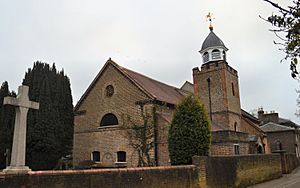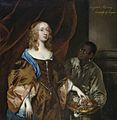Elizabeth Maitland, Duchess of Lauderdale facts for kids
Quick facts for kids Elizabeth Maitland |
|
|---|---|
| Duchess of Lauderdale | |
| Portrait of Elizabeth Murray (1626–1698), later successively Lady Tollemache, Countess of Dysart and Duchess of Lauderdale (1626–1698) | |
| Spouse(s) | |
| Issue | |
|
|
| Father | William Murray, 1st Earl of Dysart |
| Mother | Catherine Murray, Countess of Dysart |
| Born | 28 September 1626 |
| Died | 5 June 1698 (aged 71) Ham House, London |
| Burial | St Peter's Church, Petersham |
Elizabeth Maitland, Duchess of Lauderdale, 2nd Countess of Dysart (born Murray; 28 September 1626 – 5 June 1698) was an important Scottish noblewoman. She was the oldest daughter of William Murray, 1st Earl of Dysart and his wife Catherine Murray, Countess of Dysart. Elizabeth grew up in the English royal court before the English Civil War. Her parents made sure she received a good education.
Elizabeth first married Sir Lionel Tollemache, 3rd Baronet. They had eleven children together. After Lionel's death, she married John Maitland, 1st Duke of Lauderdale in 1672. She then became very close to the King's court again. Elizabeth was known for her strong political influence. She also supported King Charles II when he was in exile. She was part of a secret group called the Sealed Knot. This group worked to bring the monarchy back after King Charles I was executed. Elizabeth was also a lifelong supporter of artists, especially Peter Lely. She passed away at 71 at her home, Ham House, near Richmond. She is buried in the nearby church.
Contents
Elizabeth's Early Life
Elizabeth Murray was the oldest of four daughters. Her father, William Murray, 1st Earl of Dysart, was a close friend of King Charles I. Elizabeth was born in 1626. Her family moved to Ham House near Richmond that same year. She spent her childhood there. Her father made sure she got a full education. This was unusual for girls at that time. Her mother taught her how to manage a household well.
The English Civil War and First Marriage
During the English Civil War, Elizabeth's father was often away. He was serving the King. Her mother took Elizabeth and her sisters to Oxford to visit him. Elizabeth became known for her charm and beauty. In 1648, she married Sir Lionel Tollemache, 3rd Baronet. This was a smart choice because he stayed out of politics. Their marriage was stable and happy. The next year, Ham House was put under Lionel's care. This helped protect the family estate during the war.
At first, Sir Lionel and Lady Dysart lived in Suffolk. This was a quiet area, away from the war. They had eleven children. Five of them lived to be adults:
- Lionel Tollemache, 3rd Earl of Dysart, who became Earl of Dysart after his mother died.
- Thomas Tollemache, a lieutenant-general and Member of Parliament.
- Elizabeth Tollemache (1659–1735), who married Archibald Campbell, 1st Duke of Argyll.
- William Tollemache (1661–1694), a captain in the Royal Navy.
- Catherine Tollemache, who married two Scottish lords.
Elizabeth often stayed at Ham House after her mother died in 1649. She met Oliver Cromwell, a leader of the Parliamentarian army. This friendship helped hide her support for the King. She even used this connection to save John Maitland after he was captured. In 1653, she joined the Sealed Knot, a secret Royalist group. She wrote letters to King Charles II, who was in exile. She often traveled to Europe to deliver messages. She even invented a special invisible ink for secret letters.
When her father died in 1655, she inherited his titles. She became Countess of Dysart. In 1660, King Charles II was crowned. He gave Elizabeth an annual payment of £800. She and her husband also received land around Ham House. This was to thank her father and her for their service. Some people accused her of witchcraft because she had so much political influence. They also spread false rumors about her. Her title as Countess of Dysart was confirmed in 1670. This also made it clear that women could inherit the title if there were no male heirs.
Elizabeth's Second Marriage
In 1669, her husband Lionel died in France. Elizabeth then owned Ham House and other properties. Soon after, she became close with John Maitland, 1st Duke of Lauderdale. He was a Scottish nobleman and politician. Elizabeth became very involved in the royal court through her influence on him. She and John married in February 1672. This was after his first wife passed away. John became a Duke in May 1672. This made Elizabeth the Duchess of Lauderdale. He was an important government official for King Charles II.
A month after their wedding, they traveled to Scotland. Elizabeth insisted on going with her husband to the Scottish Parliament. She even demanded chairs for herself and her ladies-in-waiting. This caused some talk and disapproval. The Duke and Duchess became known for their power, wealth, and fancy lifestyle.
In 1671, Elizabeth asked her cousin, the architect William Bruce, for advice. She wanted a new gate for Ham House. This was because King Charles II and his wife, Queen Catherine, planned to visit. Bruce sent her a design for the gate. The iron gates were made in England and painted blue. Elizabeth later argued with Bruce over other work.
In 1673, Elizabeth and her husband started making changes to Ham House. They wanted to make it bigger and more modern. They added new royal rooms on the first floor. They also created separate apartments for themselves on the ground floor. Elizabeth even had a bathroom built in the basement. This shows she cared about cleanliness.
Later Life and Death
In 1680, Elizabeth became very ill with gout. This affected her health for the rest of her life. Her husband John also became sick that year. He resigned from his government jobs. Elizabeth took care of him at Ham House. John died in April 1682. After his death, Elizabeth had a legal fight with his brother. The brother wanted Elizabeth to pay for John's debts and funeral.
The Duke had used Ham House as a loan to pay for changes to his Scottish homes. These homes were left to his brother in his will. Ham House was returned to Elizabeth. The Duchess sold some of her jewelry and books to pay off the loans. The dispute lasted for years. Finally, in 1688, a Scottish court decided that John's brother had to pay the debts. Elizabeth was responsible for the funeral costs.
Elizabeth suffered from gout for many years. It made it hard for her to move around. She mostly stayed on the ground floor at Ham House. But she kept writing letters to friends and family. She was very interested in news from the royal court. In 1694, she lost two of her sons, Thomas and William.
The Duchess of Lauderdale died at 71 on 5 June 1698 at Ham House. She was buried in a vault under the church in Petersham Parish Church. This was what she wanted.
Elizabeth Murray's story was first told in a book in 1975. It was called Elizabeth of the Sealed Knot. Many artists painted portraits of Elizabeth during her life. These included Peter Lely, John Weesop, and Joan Carlile. She supported Lely for many years. Four of his paintings of her exist. One double portrait of her and John Maitland is still at Ham House.
Images for kids
| Peerage of Scotland | ||
|---|---|---|
| Preceded by William Murray |
Countess of Dysart 1655–1698 |
Succeeded by Lionel Tollemache |







